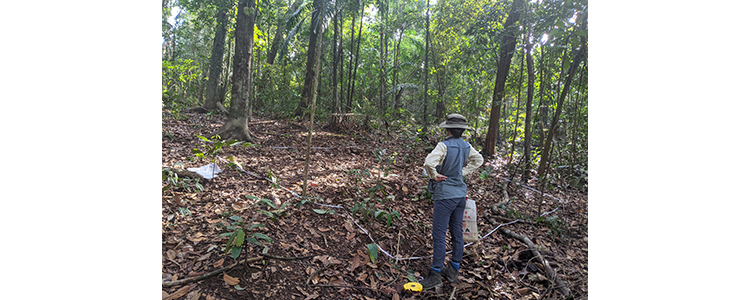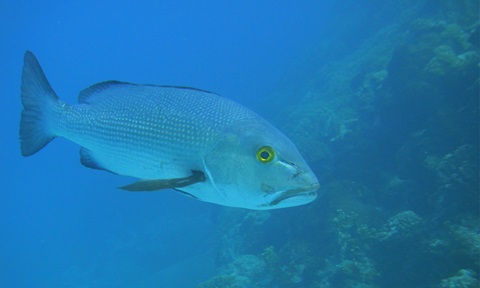Studying the impact of wild boar on Singapore’s forests
by Dr Kenny Png
 Measuring soil and vegetation properties in the wild boar research plots (left and right). A wild boar (middle). Photo credit: Kenny Png
Measuring soil and vegetation properties in the wild boar research plots (left and right). A wild boar (middle). Photo credit: Kenny Png
I am currently working to understand the impacts of wild boars on the forest vegetation and soil properties in Singapore together with our collaborators at Nparks and the University of Queensland. In forest ecosystems without a natural apex predator - like tigers – boars are likely to be abundant. Boars could damage vegetation, but on the other hand, their soil diggings can also create a patchwork of soil microhabitats to allow other plants and smaller organisms to thrive which, in turn, promotes biodiversity. A recent study in Malaysia showed that wild boars can promote plant diversity by eating smaller plants of the dominant tree species, giving less dominant plant species a better chance. As such, we are interested to see if we can detect some of these benefits here.
To do so, we are currently building fenced wild boar exclosures across Singapore to compare differences in ecosystem properties with paired unfenced plots. These exclosures are about 9m x 12m, and the fences are about 2m tall. We started scouting for 30 suitable pairs of forest plots to fence across Singapore in November 2020. Finding similar pairs of plots based on vegetation properties was somewhat challenging as tropical forests tend to show high plant species richness and heterogeneity; but on a positive note, we got more exercise hiking the forests! The construction of the fences commenced in April this year and we have recently completed all the paired plots on mainland Singapore. Since then, we have begun carrying out baseline surveys (vegetation, soil and invertebrate, camera trapping) across these plots and hope to complete this soon if, fingers crossed, the weather stays consistently nice.
Once the baseline survey is completed this year, we will return to survey the plots next in a couple of years to measure the changes between the fencing treatments. As with most research, patience is a much-needed virtue with long-term ecological experiments such as this as differences in these fencing treatments may only be more discernible beyond two, five or even 10 years. As such we hope to secure long-term funding to be able to continue to monitor shifts in ecosystem properties and maintain the fences as trees naturally falling over and breaching the fence structure is a common occurrence. Findings from this long-term study will inform long-term conservation efforts of the tropical forests of Singapore and the region.
 A sparsely vegetated research plot in Singapore. Photo credit: Kenny Png.
A sparsely vegetated research plot in Singapore. Photo credit: Kenny Png.














/enri-thumbnails/careeropportunities1f0caf1c-a12d-479c-be7c-3c04e085c617.tmb-mega-menu.jpg?Culture=en&sfvrsn=d7261e3b_1)

/cradle-thumbnails/research-capabilities1516d0ba63aa44f0b4ee77a8c05263b2.tmb-mega-menu.jpg?Culture=en&sfvrsn=1bc94f8_1)

7e6fdc03-9018-4d08-9a98-8a21acbc37ba.tmb-mega-menu.jpg?Culture=en&sfvrsn=7deaf618_1)




.tmb-listing.jpg?Culture=en&sfvrsn=cb08705a_1)

